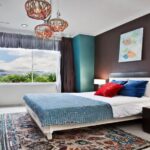By
In this article, we’ll share with you the home decorating rules that are going to make your home look so much more inviting. If you want to level up your home decorating, these ten decorating rules and tips for your home will change your life. So let’s get started.
Ideas and Tips 1: Use Properly Scaled Furniture and Accessories
Use properly scaled furniture and accessories. By properly scaled, if you have a nice large room with really high ceilings that feel nice and open, you can get some bigger-scaled furniture. So a large sofa, a very big sectional. Make sure it fills up that space nicely.
However, if you have a smaller space, like a lot of us do with maybe some lower ceilings and not as much square footage. You want to make sure you purchase a piece that makes sense for that space. So, instead of that giant sectional, you’re going to want to look for a smaller settee. Also, a chaise lounge, a loveseat, or more of an apartment-sized piece of furniture. If you have a piece of furniture or even an accessory that is just massive for the space it’s in. It’s going to make your room feel disjointed, out of place, and not very cohesive. You’re just going to feel like something is off.
Plus, you’re going to need the proper pathways for people to walk around the furniture and in and out of your space. Also, when choosing pieces that go together, you want to choose a piece of art to go over a side table or an entry table. You want to think about the same thing. If you have a larger entry table, you want to think of a larger piece of art or a mirror on top of that rather than a smaller one. You wish to ensure the same visual weight on the bottom same as on the top. And that will make your space feel more designed and better put together.
Ideas and Tips 2: Striking the Right Balance
Strive to achieve balance in your home decor. And by balance, we don’t necessarily mean you want to keep your home decor symmetrical. And by symmetry, you don’t have to have a completely mirrored design on one side to the other. You want to make your decor feel balanced by using what’s called visual weight. So, the idea of achieving balance through symmetry is easier. This is the one we recommend to you if you’re starting with interior design and home decor. And that’s mirroring a design on one side to the other.
So, on a mantel, for example, you would put a large piece of mirror or an art in the middle and then decorate either side of the mantel—the same with the same candlesticks and maybe the same plants on either end. You achieve a balanced look by keeping everything the same on both sides of that mantel. Asymmetrical is a little bit harder, so that means you don’t necessarily have an exact mirrored design. You may have the mantel example. Again, you have a larger piece of art slightly off-center. You balance that by layering a smaller piece of art on that. And then, either side of your mantel may be the same, but you have many smaller items on one side. You balance that by using some larger objects on the other.
So, the visual weight of several smaller objects versus one or two larger objects balances each other out.
Ideas and Tips 3: Creating The Art of Repetition
Use repetition to bring order to your space. We find it amazing how you can make a whole home feel much more cohesive. Only by repeating a color, a texture, or a shape repeatedly within your home. And it doesn’t have to be on the nose. We did kind of an on-the-nose version of this when we decorated our little lake house. We use lots of vintage and antique ducks everywhere. So we have those, you know, around from the kitchen countertop to in the bedroom. That’s an undeniable repetition example, and it can be more subtle than that.
You may want to choose a color like metallic gold or brass. And you want to repeat that color a few times throughout your home to make it look cohesive and balanced. Repeating an element three times in each room is about the perfect amount. So, if you’re going with that brass example, in one space, you have brass candlesticks, a brass mirror frame, and a brass picture frame, and repeating that three times will make everything look like it goes together.
Ideas and Tips 4: Create a Distinct Color Palette for your Home
Create a distinct color palette for your home. We are a huge lover of color. As much as we love white walls, we love to add colorful accessories and furniture to our space. And we have learned that defining that color scheme for your room makeover for your home decor is extremely important. Before you even start. We like to refer to the color wheel when planning out my home decor color schemes; we will leave a link to a free printable of the color wheel we have for you. We’ll link that down in the description box below.
There are three different color schemes you can go with for your home decoration, accessories, furniture, etc. The first one is called monochromatic, and that’s when you choose one color, and you can choose shades of that color and use that color only—maybe paired with some neutrals like white, metallic, brown, or black in your space. This is a very minimalistic, calming look, and pulling off the second color scheme is straightforward. You can choose what is called analogous, and that’s when you choose two colors beside each other on the color wheel.
So, for example, blue and green, repeat those colors with a neutral thrown in throughout your space. This also creates a calming look, but it’s more interesting than going solely monochromatic. And the third color scheme you can choose is a complementary color scheme. That’s when you select two colors or two shades of colors opposite each other on the color wheel—so red and green or more subtle shades of those pink and mint green.
One of our favorite color combinations using this complementary color scheme is more exciting. A bit more fun, bolder, and fresher, and you can also pair those two colors with a neutral. We also love this trick. It’s called the 60-30-10 Rule, where if you’re using three colors or two colors and a neutral color, you choose a dominant color to use in about 60% of your space.
So usually, we would choose neutral, like white walls, for example, and then select a secondary color to use in 30% of your space. You may want to use some green like these green appliances in your tiny lake house. And then 10% of your space can be a secondary color, maybe with some accents using this — color rule, which makes it easy to combine colors in your space.
Ideas and Tips 5: Abundance of Textures
This is usually the one thing that’s missing when people are finished with their space. They need to find out why it isn’t cozy or inviting. It’s generally because there’s a lack of texture, especially if you go for more of a neutral or monochromatic color scheme. You want to add a variety of textures to your textiles and furniture, even to your wall coverings. Just to give your space more interest. So, some textures you can look for are smooth textures like metal and glass.
You can look for bumpy textures like woven baskets or nubby blankets. Go for furry textures like a faux fur blanket or a faux fur pillow, and then maybe even some rough textures, like some wood or stone. And if you add all of these together, you will create this exciting, cozy, enveloping feeling space. We like to make a mood board to see if our space has enough color and exciting texture. You can use a program like Photoshop or a free site like Canva to create a mood board—just a little graphic.
You can make a square one and pull in the paint colors you might want to use as accent colors. Then, copy and paste photos of some furniture and accessories you want to use. Pull it all into this image. When we pull everything in there, we see if there is a lack of texture or cohesion with the colors. Then, we will know how to keep going with my room makeover. If we need to source some different items. Your Canva Mood Board Templates + Mini Course! Speaking of mood boards, we are so excited. We launched our first mini-course and template pack, so I have a package of Canva Moodboard templates for you.
Ideas and Tips 6: Establish a Clear Focal Point
Establish a clear focal point. This has been a fault of mine in the past because we do love decorating. We do love stuff. We do love exciting aspects of a space. However, when you’re decorating, pick one focal point. One thing that the eye will be drawn to immediately in the space, and then everything else should complement that focal point. Some focal points are apparent.
So, for example, in your living room, the fireplace commands to be the obvious focal point. It’s darker than the rest of the space. It’s big. You have a beautiful mantel. So that’s where you would want to decorate first. And you’d want everything in the space, the furniture, the rug, the accent pieces to complement that fireplace and not take away from it. If we had another piece of giant dark artwork in the space, it might be confusing to know where to look first, second, third, etc.
In some rooms, there’s yet to be an obvious focal point. So then you, as the home decorator, have the task of making one. So whether you do it with a big piece of DIY artwork or with some floral statement drapes, Or have an attractive color or pattern, there are many ways to create that focal point in space to draw the eye. Rule home decorating.
Ideas and Tips 7: Lay your Space First
Lay your space first before you even touch it. And by that, putting together a floor plan for your space is an excellent idea. It doesn’t have to be fancy. You can do it with a pencil and some graph paper. You can print out free graph paper online. Just Google “free graph paper printable,” or you could even use a program like floorplanner.com. That’s the one that we recommend. If you are new to using the computer to design spaces or want something a little bit trickier, there are many more options.
We’d recommend using sketchup.com so floorplanner.com is a little bit easier sketchup.com is a little bit harder but has more options. When you design your floorplan, first, we mean layout your room. And its dimensions. Put the furniture you want in there with the exact dimensions as the furniture on your mood board.
You’re going to see if it’s going to work or not. If you lay it out on paper or the computer, that will save you so much hassle later. As you do this layout, too, it’s going to help you nail down the focal point for your space. What it is, or what you can put in the pathway that people are going to use.
Place a conversation area where you want to use appropriate lighting. If you know where people are sitting, where could you put a floor lamp and the proper seating for your room? So whether it’s a large sofa, a small sofa, a set of accent chairs, etc.
Ideas and Tips 8: Sourced from a Variety of Places
Sourced from a variety of places. And what we mean by that is don’t just go to a big box store and have a look at their showroom and buy the set of furniture and plunk it in your space. That will make your space look like a big box store. This is a way to make your home appear more unique, designer, and collected. Look at various individual sources when finding the furniture or accessories and all of those little things you want to add to your space.
So, you can go to a big box store and buy a piece or two from there. But remember to look at the thrift store and think outside the box. Think about it: If you could paint or restore something, go to garage sales or antique stores. You can also look on Facebook or the marketplace and pull all of those pieces or photos of those pieces onto your mood board. And see how they converse and match, and then go from there. That will give your home this more collected look, just more exciting and so much more unique to match your personality.
Ideas and Tips 9: Put Thoughtful Details
The little details can make a big difference. So you might not think about those little things or don’t take enough time to choose. Things like the little knobs on your cupboards, your door knobs, hinges, smaller accessories, hooks on your wall. Those can add to your space. So think about that Rule, about repetition, right?
If you want to make your home feel more cohesive, choose brass-colored knobs. For example, tying in some brass-colored accessories in the rest of your home is going to make your home feel more cohesive. Also, it is more high-end and better designed.
Ideas and Tips 10: Painting Perfection
This one is so important. This one can go well if you follow it; make sure you sample paint in your room. Don’t just choose paint by the paint chip. Okay, I have done this recently, and it magically worked out for me. But it usually does not work out to choose the paint based on the chip and not sample it on the wall of your home. Paint is going to look significantly different in your location with your lighting and your exposure than it does on the tiny little chip in the store.
So, we recommend grabbing a sample pot of the paint color you want to try. Grab a big piece of Bristol board at least three feet by three feet or even two feet by two feet is a good size. Paint that whole piece and then tape it up on your wall. You want to tape it up on the wall; You’re going to paint, sit and stare at it, and analyze it for at least a few days. You want to see it in the morning, afternoon, evening. You want to see it with sunshine; You want to see it with your interior lighting. And that will give you a far better idea of how that paint will act in your space.
You might be surprised at how differently the paint looks in your home than at the paint store. We hope you found these decorating rules helpful. They will undoubtedly help you become a much better home decorator.
Conclusion
These ten decorating rules are valuable guidelines to enhance the beauty and functionality of your home. Remember that decorating is a personal and evolving process; these rules are meant to be flexible. Feel free to adapt them to your taste, experiment with different styles, and, most importantly, create a space that feels uniquely yours.
FAQs
Q: How do you make house decorating ideas?
Ans: Create a statement accent wall by hanging frames of different shapes and sizes. Then, cover everything with a fresh coat of paint, preferably something bold.
Q: What is a home decor?
Ans: Home Décor, short for home decoration, interior décor circumscribes items, and you guessed it, decorations that make the look of your home quite excellent.
Q: Why does decorating make me happy?
Ans: Creating our perfect space or sanctuary during our busy lives renews our energy and gives us the space and peace of mind we all need.





